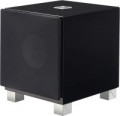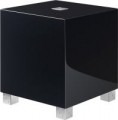—
Closed type. The simplest type of construction: a closed (sometimes hermetically sealed) case with a speaker placed on the front panel. It is believed that such subwoofers have low sensitivity, which, however, is offset by high sound transmission accuracy and low distortion.
—
Phase inverter type. In the cases of such subwoofers, a tube is installed that has an outlet to the surrounding space. The length of the tube is chosen so that a signal comes out of it, inverted in phase relative to the signal from the front of the cone (in other words, from the main speaker). This improves the sound of the subwoofer and enhances the sound pressure. The disadvantage of a phase inverter is the additional noise from the sound stream in the tube.
—
With a passive radiator. A design similar to a phase inverter (see above) in terms of purpose and principle of operation, however, instead of a tube, such subwoofers use the so-called passive emitter. In fact, it is an ordinary speaker, devoid of a coil and a magnet and playing the same role as the phase inverter tube. The use of a passive radiator allows you to get rid of the noise of the air flow, characteristic of phase inverters.
Rated power of the subwoofer. Technically, this is the highest average (rms) sound power at which the device can work normally (without sound distortion and damage to components) for an unlimited time. Simply put, the more powerful the subwoofer, the louder it is. The choice for this parameter depends primarily on the size of the space / room that is planned to be covered; detailed recommendations for different situations can be found in special sources.
Also, the power is directly related to the characteristics of the amplifier used with the subwoofer. For active subwoofers (see "Type"), this item actually indicates the nominal power of the built-in amplifier; the speaker itself can be more powerful, but it doesn't matter anymore. For passive models, the power rating corresponds to the highest amplifier power that can be connected to the speaker without the risk of damaging it at high volume.

